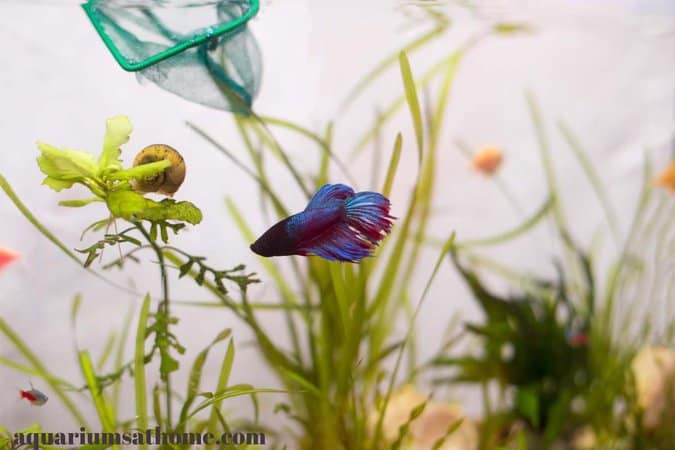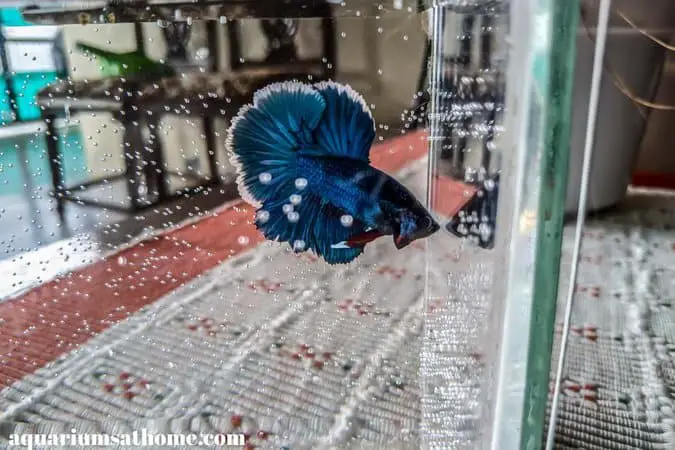Betta fish (also known as Siamese fighting fish) are popular water pets known for their active nature, vibrant colors, and flowing fins. Setting up a proper tank for your betta fish is essential to ensure their well-being and provide them with a comfortable environment in which to thrive. In this article, we’ll guide you through the process of setting up a betta fish tank step by step.
Before diving into the details, let’s briefly review what betta fish are and their requirements. Betta fish are tropical freshwater fish native to Southeast Asia. They’re known for their aggressive nature which is why they’re often kept alone in fish tanks. Understanding their characteristics and specific needs will help us create an ideal habitat for them.
Characteristics of Betta Fish
Betta fish have labyrinth organs that allow them to breathe air from the water’s surface which is why they can survive in low-oxygen environments. They’re tropical fish and thrive in warm water with a temperature range of 75-82°F (24-28°C). Betta fish are also known for their beautiful, long, flowing fins and vibrant colors, making them a visually appealing choice for aquarium enthusiasts.
Choosing the Right Betta Fish Tank
When selecting a tank for your betta fish, it’s important to consider their specific requirements. Betta fish tanks should have a minimum capacity of 5 gallons (19 liters) to provide enough space for the fish to swim and explore. Avoid small bowls or containers as they restrict the fish’s movement and limit both the filtration and heating options.

Setting Up the Betta Fish Tank
Now that we have a basic understanding of betta fish and their needs, let’s move on to setting up the proper tank which includes the following:
Tank Size and Capacity
Choose a tank with a capacity of at least 5 gallons (19 liters). A larger tank provides more stable water conditions and allows your betta fish to have ample swimming space. It’s imperative that the tank has a secure lid which prevents both the fish from jumping out or other animals from getting in.
Selecting the Tank Location
Find a suitable location for your betta fish tank. Avoid placing it near direct sunlight or drafty areas as these can cause fluctuations in temperature and water quality. Also, make sure the surface is sturdy enough to support the weight of the tank when filled with water.
Installing the Tank Equipment
Proper equipment is essential for maintaining a healthy betta fish tank. The key components to install include the following:
Heater
Betta fish are tropical and require a warm environment within the heat range mentioned earlier. Install a reliable aquarium heater and set it to the appropriate temperature to ensure a comfortable habitat for your betta.
Filter
A filter helps keep the water clean and free from debris and/or toxins. Choose a powered filter with a gentle flow, as betta fish don’t like strong currents. A well functioning filter will help keep the tank and eliminate the need for excessive water changes.
Lighting
While betta fish don’t require intense lighting, be sure to provide a light source that helps to showcase their vibrant colors while establishing the appropriate day-night cycle. Consider using a low-intensity LED aquarium light with a multi-color feature.
Adding Substrate and Decorations
To create a natural and visually appealing environment for your betta fish, add substrate and decorations to the tank. Use a fine-grained substrate like sand or aquarium gravel and avoid sharp objects that may injure your fish.
Introduce a few plants (live or artificial) to provide hiding spots and create a sense of security for your betta. Real greenery also helps to oxygenate the water and reduce ammonia levels.
Filling the Tank with Water
Before adding water to the tank, treat it with a water conditioner to remove chlorine and heavy metals that can be harmful to your betta fish. Fill the tank slowly, avoiding excessive agitation that may disturb the substrate or decorations.
Aim for a water level that allows your betta to swim comfortably without reaching the lid. Keep it topped up with clean, pretreated water if you live in a dry climate where evaporation is an issue.
Cycling the Tank
Cycling the tank is a crucial step in establishing a healthy and stable aquatic environment for your betta fish.
The Nitrogen Cycle
The nitrogen cycle is a biological process that converts toxic ammonia produced by fish waste and decaying matter into less harmful substances. Beneficial bacteria play a vital role in this process as they convert ammonia into nitrite and eventually into nitrate.
Importance of Cycling
Cycling the tank helps establish a balanced ecosystem and prevents ammonia and nitrite spikes which can be harmful to your betta fish. It typically takes several weeks for the beneficial bacteria to colonize the tank and establish a stable nitrogen cycle.
How to Cycle the Tank
To initiate the cycling process, you can add a bacterial supplement or use a “fishless” cycling method. In a fishless cycle, you add a source of ammonia (such as fish food or liquid ammonia) to feed the beneficial bacteria.
Regularly test the water parameters using a test kit to monitor the levels of ammonia, nitrite, and nitrate. Once the cycle is complete and ammonia and nitrite levels are consistently zero, your tank is ready for fish.
Introducing Your Betta Fish
Before introducing your betta fish to the tank, it’s important to acclimate them to the new environment.
Acclimating Your Betta Fish
Float the bag or container containing your betta fish in the tank for about 15-20 minutes. This allows the temperature in the bag to gradually equalize with the tank water. Afterward, open the bag and add small amounts of tank water to it every few minutes. This helps your betta adjust to the new water conditions.
Releasing the Betta into the Tank
Using a net, gently transfer your betta fish from the bag to the tank. Avoid adding the bag water to the tank as it may contain traces of ammonia or other toxins. Observe your betta for any signs of stress during the release process. If the fish appears calm, allow it to explore its new habitat at its own pace.
Tank Maintenance
Maintaining a clean and healthy tank is crucial for the well-being of your betta fish. Here are some key aspects of tank maintenance:
Regular Water Changes
Perform regular water changes to remove accumulated toxins and maintain water quality. Aim to replace approximately 20-30% of the water each week. Use a siphon or gravel vacuum to excrete debris and waste from the substrate during water changes.
Cleaning the Tank
Periodically clean the tank walls, decorations, and equipment to prevent the buildup of algae or other contaminants. Use a soft algae scrubber or a clean sponge to gently remove algae without disturbing your betta fish.
Monitoring Water Parameters
Regularly test the water parameters using a test kit. Maintain appropriate parameters (temperature, pH levels, ammonia levels, etc.) and adjust as needed to ensure a stable and optimal environment for your betta fish.
Feeding Your Betta Fish
Proper nutrition is essential for the health and vitality of your betta fish. Here are some guidelines for feeding:
Proper Betta Fish Diet
Betta fish are carnivorous and require a diet primarily consisting of high-quality, betta-specific pellets or flakes. Look for products that offer a balanced mix of protein, fats and essential nutrients. Occasionally supplement their diet with frozen or live foods such as brine shrimp or daphnia to provide variety.
Feeding Schedule
Feed your betta fish small amounts two to three times a day. Avoid overfeeding as bettas tend to overeat, leading to obesity and other related health issues. Remove any uneaten food after a few minutes to maintain water cleanliness and quality.
Overfeeding and Obesity
Overfeeding betta fish can lead to obesity, bloating, and other health problems. Maintain a strict feeding schedule and monitor your betta’s weight and overall appearance. Adjust the portion sizes accordingly to ensure your betta remains in a healthy condition.

Betta Fish Tank Troubleshooting
Occasionally, you may encounter challenges with your betta fish tank. Here are some common issues and their solutions:
Common Tank Problems
Algae Growth: Excessive algae growth can indicate an imbalance of light and nutrients. Adjust the lighting duration/intensity and consider adding live plants to compete with algae for nutrients.
Cloudy Water: Cloudy water may be caused by an excess of organic waste or particles. Increase water changes and ensure adequate filtration and circulation.
Temperature Fluctuations: Sudden temperature changes can stress betta fish. Use a reliable heater and monitor the ambient temperature to maintain a consistent and appropriate range.
Health Issues and Treatment
Fin Rot: Fin rot is a bacterial infection characterized by frayed or deteriorating fins. Improve water quality, consider medication, and ensure a stress-free environment to aid in recovery.
Ich: Ich is a parasitic infection that causes white spots on the fish’s body. Raise the water temperature and use appropriate medication to treat ich.
Dealing with Aggressive Behavior
If your betta fish displays aggressive behavior such as flaring, chasing, or biting, it may be necessary to separate it from tankmates or rearrange the tank to create more territories. Provide hiding spots and ensure each fish has ample space to minimize aggression.
Final Thoughts
Setting up a betta fish tank requires careful consideration of their specific needs and maintaining a suitable environment. By providing the right tank size, equipment, water conditions, and nutrition, you can create a thriving habitat for your betta fish. Remember to monitor their health, perform regular maintenance, and enjoy the beauty and companionship these magnificent fish bring to your home.
FAQs
Can betta fish live in small bowls? Betta fish require a minimum tank size of 5 gallons to thrive. Small bowls restrict their movement and limit filtration and heating options which can lead to an unhealthy environment.
How often should I clean the betta fish tank? Regular maintenance is crucial. Perform partial water changes of 15-25% weekly, clean the tank walls, decorations, and equipment periodically, and monitor water parameters to ensure a clean and healthy environment for your betta fish.
Can betta fish live with other fish? Betta fish are known for their territorial and aggressive nature, especially towards other bettas and fish with long, flowing fins. It’s best to keep them in a separate tank without tankmates to prevent stress and aggression.
What temperature should the betta fish tank be? The ideal temperature range for betta fish is 75-82°F (24-28°C). Use a reliable aquarium heater to maintain a consistent temperature within this range.
How long do betta fish live? With proper care, betta fish can live for an average of 3-5 years. Providing them with a suitable tank, balanced nutrition, and a stress-free environment can only improve to their longevity.






